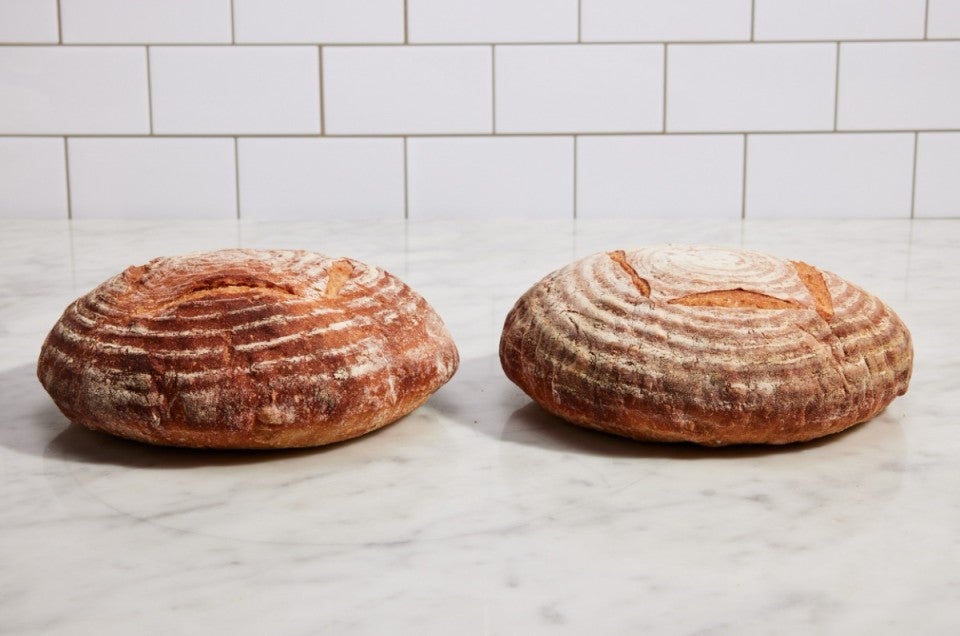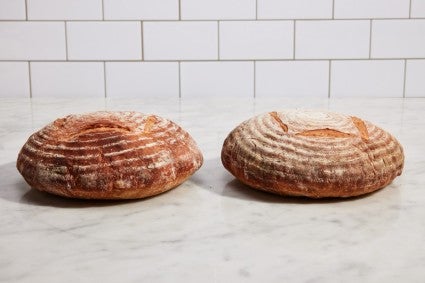Baking trials: Does a baking stone really make a difference in your bread?
We tested how a baking stone can impact your breads' rise, color, and more.


In the past, we’ve written about the effects of different types of bakeware on your baked goods. Wondering if a pie bakes best in a metal, glass, or ceramic pie pan? We’ve got you covered. Same for cakes baked in glass, metal, and stoneware.
But what about bread? We wondered if there was an optimal way to bake free-form loaves that don’t require bakeware, but rather a specific baking surface: a bread and pizza stone. Does baking bread or pizza on a stone really make a difference in the finished product? We did the testing so you don’t have to.
The type of vessel you bake in, or on, will have an impact on your results. That’s because different materials transfer heat from the oven to your baked goods in different ways. Take brownies, for example. Glass takes longer to heat up, so if you bake brownies in a glass pan the edges may overbake by the time the center cooks through. Meanwhile, brownies baked in a metal pan will have shorter, softer edges because metal conducts heat more efficiently.
To test the impact of baking bread on a pizza stone, I made several loaves (as well as both pitas and pizza) side-by-side: one on an aluminum baking sheet set directly on the oven rack and the other directly on a preheated King Arthur Bread and Pizza Stone, made of cordierite. A food-safe mineral compound, cordierite is essentially stone, and stone benefits baking by absorbing and holding on to heat, which it then transfers to your bread (or pizza) while baking. Stone is also slow to cool down, so it can radiate heat consistently for a long time. These qualities cause baked goods to cook and brown more evenly.
By comparison, aluminum is a conductor, meaning it’s great at passing heat through itself and into your dough and heats and cools down relatively quickly. Unfortunately, aluminum heats inconsistently and can cause both uneven baking and browning on baked goods.

I first tested the difference between these two materials using our Artisan Hearth Bread recipe, where we call for baking on a stone. The dough baked on the stone had better oven spring — that burst of rising that occurs in the oven before the bread develops its exterior crust — than the one baked on the baking sheet. Since oven spring is partly caused by the temperature increase of the gases in the dough, this tells me that the stone helped deliver ample high heat to the dough right from the start of baking. As a result, the loaf baked on stone was taller and had a more pleasantly rounded boule shape, while the loaf baked on a baking sheet was somewhat flat and disk-like by comparison.

I next turned to one of our most popular sourdough recipes: Naturally Leavened Sourdough Bread. While both loaves took on nice color, the one baked on the aluminum baking sheet was unevenly browned. The loaf baked on stone was more evenly browned all over, including the bottom. How dark you like your bread is largely a matter of preference, and personally, I’d rather eat the one baked on the tray for its more nuanced, nutty flavor. If I judge the two loaves on the evenness of the caramelization, however, the stone wins. Looking from the top and bottom, the tray-baked loaf was splotchier than the stone-baked one, though this isn’t a huge deal unless you’re concerned about inconsistent flavor from bite to bite.

In our Spelt Pita recipe, we offer instructions for both stone baking and tray baking. Pitas baked on the pizza stone puffed up within 1 to 1 1/2 minutes — a result of the near-instant, intense heat they get from the stone. They were fully baked in 3 minutes and remained soft and pliable. By comparison, the pitas baked on the aluminum baking sheet took twice as long to puff and required a longer bake time overall. The result: drier, more leathery pitas that had the tendency to crack when deflated. Though both methods work, the award goes to stone-baked pitas, as they remain pliant and soft enough to split and stuff.

Our Light and Crispy Pizza is meant to have a crisp, crunchy crust, and here the stone definitely delivered. Once again, I found that the even, intense heat from the stone caused consistent browning all over. And, like with the pitas, the pizza cooks more quickly than a hearth loaf, so it needs an immediate blast of heat so the crust gets crispy and crunchy before the toppings burn.
Meanwhile, the aluminum baking sheet offered a more unevenly browned pizza with less color and a less crispy texture. A blonde, soft pizza is better than no pizza, but if you want a crisp, crunchy crust, the stone is the way to go.
My tests revealed that using a bread and pizza stone for breads really does make a difference, and depending on the recipe, that difference may be more or less stark. The stone creates faster, superior rise in breads where this matters, like pita and the artisan hearth bread. It also ensured more even browning on everything I tested, as well as crispier, crunchier crust on pizza.

Still wondering if you should invest in a baking stone? Not only is it great for bread, pizza, and pitas, but baking your pies on a stone also helps prevent soggy bottoms. The consistent heat from the stone coupled with the conductivity of a metal pan helps ensure your pies are fully cooked and evenly browned on the bottom.
Cover photo by Rick Holbrook; food styling by Kaitlin Wayne.


